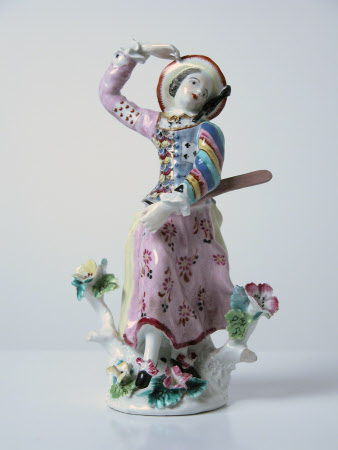Harlequin and Columbine
Bow Porcelain Factory (fl.c. 1748-1774)
Category
Ceramics
Date
1755
Materials
Soft paste porcelain
Place of origin
Stratford-le-Bow
Order this imageCollection
Upton House, Warwickshire
NT 446159
Summary
Pair of figures, Harlequin and Columbine (or Harlequine), soft-paste porcelain painted with enamel colours, made by the Bow porcelain factory, London, about 1755. Harlequin wears a mask and Columbine is in dancing attitude, both with square holes at the back for metal candlestick attachments and on flower encrusted tree-trunk supports.
Full description
In the 18th century, European porcelain figures were made to present and decorate the dessert course of a meal. They replaced earlier types of wax and sugar figures which often expressed political connections and power. The dessert was the most expensive course in the 18th century. Extravagant, edible creations amidst a fine porcelain table setting demonstrated the wealth and fashionable ‘good’ taste of the hosts. Designed to be seen in the round, these porcelain figures were often displayed in thematic groups, down the centre of a table with candelabra, on mirrored glass to enhance the spectacle. Porcelain was, until the 1700s, almost exclusively produced in East Asia and extremely desirable, fetching very high prices in Europe. It was the Meissen factory in Germany who first managed to make a type of hard-paste porcelain, from about 1710. Soon other European factories followed their lead, in response to consumer demand. Harlequin (Inv. 446159.1) was one of the central characters in the ‘Commedia dell’arte’, a form of Italian street theatre involving elaborate costumes and masks. The character was developed from the 16th century as a servant known for his trickery and humour. His love interest is Columbine (Inv.446159.2) who was a maid to another character, Isabella. She may even represent Harlequine (female counterpart to Harlequin) who was a character in her own right. Harlequin can also be depicted with a full-mask or without any mask, instead with exaggerated facial features. In the 18th century the black or brown colour of mask was associated with Harlequin’s rural origins, referring to skin darkened by the sun through outdoor work. Alongside he was also thought to derive from ancient Roman theatre, representing a person of African descent. Harlequin’s black mask could also relate to European depictions of the devil. In the 19th century, versions of these characters were associated with British pantomimes, or performed as afterpiece following a comic opera, such as ‘Harlequin Skeleton’. These were some of the early beginnings of ‘blackface’ shows; a performance tradition in the United States of America, and overseas, for over 100 years from the 1830s. Stereotypes embodied in the stock characters of ‘blackface minstrels’ (white performers [sometimes black performers] painting their skin black and exaggerating their lips) played a significant role in cementing and proliferating racist attitudes. Harlequins were made at the Chelsea porcelain factory, London, from about 1749-52 (see V&A inv. 2-1968) and the Bow porcelain factory from about 1750, the latter may copy Chelsea or Meissen prototypes. Both the Meissen and Bow Harlequins are ultimately based on a figure in the background of an engraving by Charles-Nicolas Cochin (1688-1754) after Jean-Antoine Watteau (1684-1721), ‘L’Amour au théâtre Italien’, which was also the source for a Bow group, circa 1752, of Scaramouche and Isabella. Many of these early Bow figures including Harlequin, appear in a 1751 engraving by Louis Philippe Boitard (fl.1733-63) published in London in ‘The Scribleriad: an Heroic poem, Book II’, an exposé on false tastes and science. The figures depicted may have actually been intended to represent sugar sculpture.
Makers and roles
Bow Porcelain Factory (fl.c. 1748-1774), maker

